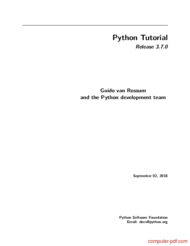Python Tutorial PDF – Learn Python with Step-by-Step Guides
Unlocking the power of programming has never been more accessible, and Python stands at the forefront of this digital revolution. With its clean syntax and versatile applications, Python is the go-to language for beginners and seasoned developers alike. Whether you're looking to dive into data analysis, web development, or automation, mastering Python opens up a world of possibilities. This comprehensive guide presents a treasure trove of free Python tutorial PDF designed to elevate your coding skills. From fundamental concepts to advanced techniques, our curated resources will empower you to learn at your own pace. Dive into projects, enhance your understanding, and connect with a community of like-minded learners. Your journey towards Python mastery starts here—let's transform your potential into proficiency!
Learning the Python Tutorial
Python is one of the most popular and versatile programming languages in the world, known for its simplicity, readability, and wide range of applications. From web development and data analysis to artificial intelligence and scientific computing, Python powers some of the most innovative technologies today. Its beginner-friendly syntax and extensive libraries make it an ideal choice for both newcomers and experienced developers.
This Python tutorial PDF is designed to help you harness the power of Python, whether you're just starting out or looking to expand your skills. It begins with the fundamentals, including Python syntax, interpreter usage, and an informal introduction to programming concepts. As you progress, the tutorial delves into more advanced topics such as control flow tools, data structures, and modules, providing a solid foundation for building real-world applications.
The PDF also covers essential programming practices like error handling, classes, and a detailed tour of Python’s standard library, which is packed with tools to streamline your development process. Additionally, it explores practical topics like virtual environments, package management, and floating-point arithmetic, ensuring you’re well-equipped to tackle complex projects.
Whether you’re a student, a professional, or a hobbyist, this Python tutorial PDF is your gateway to mastering Python. With clear explanations, practical examples, and a structured approach, it’s the perfect resource for self-paced learning. Download this PDF today and take the first step toward becoming a proficient Python developer!
| Level : | Beginners |
| Created : | June 17, 2020 |
| Size : | 614.5 KB |
| File type : | |
| Pages : | 155 |
| Author : | Guido van Rossum and the Python development team |
| Downloads : | 175518 |
